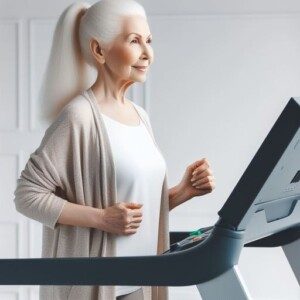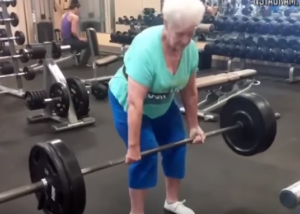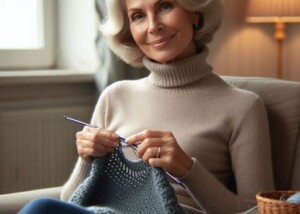The best strength training exercises for the elderly are the same for both men and women.
If you’re elderly or of “senior” age, you should strength train — no excuses. This means lift weights.
Elderly women, especially, should lift weights, to help fight off brittle bone disease which they are more at risk for than are men.
If you’re over 65 ask yourself:
- Do I want to dance at the next wedding of a grandchild?
- Or would I rather be pushed in a wheelchair into the reception hall?
Top 5 Strength Training Exercises for Elderly Men and Women
A “top 5” list will vary from one personal trainer or fitness expert to the next.
But usually, there is overlap with at least two types of exercises.
A “top 5” list will also depend on the physical condition of people over 65.
Some are already active (golf, swimming, yoga, hiking), while others are very sedentary and get winded just walking quickly in a parking lot.
Any five of the following strength training exercises are great for the elderly population.
#1) “Bodyweight squats are an excellent strength training routine for seniors because they help increase your lower-body strength allowing you to preserve the vital muscle tissue that decreases with age and inactivity,” says Monica Charlton, a senior exercise specialist and certified Silver Sneakers/personal trainer out of New Orleans.
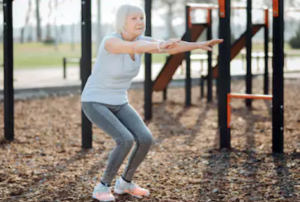
Bodyweight squat Shutterstock/Dmytro Zinkevych
#2) Standing up from a chair and sitting down for repetitions. Don’t plop down; lower into the chair with control every time. This is sometimes referred to as chair squatting.
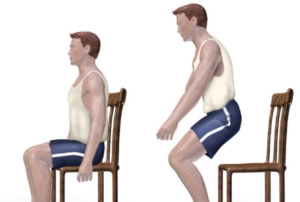
BrusBlaus
“The easiest way to ease into bodyweight squats is by doing chair squats,” says Charlton. “This helps you get the correct form while also giving you a chair to help with balance.
“Before going into full-blown squats, you can even start in a seated position and push up, holding the tension for a few seconds, and then go back down. This works your muscles and prepares you for regular squats.”
#3) Pushups, modified to your level, such as knees on floor, or standing pushup in which you’re pushing off a countertop.
“Pushups are still some of the best arm and chest exercises you can do, even as you age,” says Charlton.
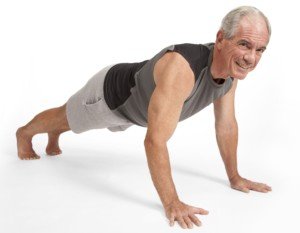
You’ll need to first start out with your hands on a countertop, then progress to your knees on the floor, and hopefully, you’ll eventually be able to do a standard pushup. Shutterstock/Straight 8 Photography
“Pushups work the same muscles as the chest press, but it also stretches them and works to stabilize your core muscles to protect your lower back,” says Charlton.
#4) Leg press. “An important way to continue strengthening your muscles is to work them constantly in a sitting up and down motion,” says Charlton.
“A leg press can work for this when done on a lower weight. This motion can help improve strength in the quads, buttocks and hamstrings.”
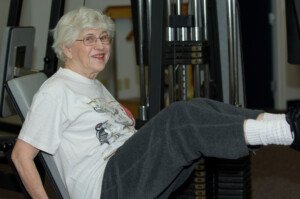
Leg press. Shutterstock/Wendy M. Simmons
#5) Deadlift. “Deadlifts work wonders for your lower body,” says Charlton. “However, they can be very dangerous when done incorrectly.
“To get the best benefits and avoid injury, a personal trainer should be there to assist and make sure you have the correct form.
“The deadlift motion is used in everyday activities — from picking up grandchildren to moving laundry baskets.
“To be precise with your deadlift, it’s best to start out practicing at home, using your own body weight,” and building up to, say, holding with straight arms in front of you a tray with a few books on it for weight, “and then build up with a professional’s help at the gym.”
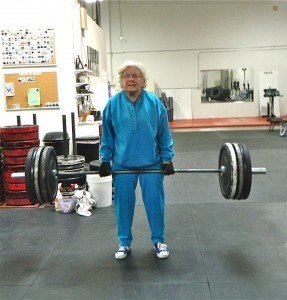
Deadlift
#5. Row. “Resistance bands can be very helpful for this when tied to a banister or pole,” says Charlton.
“With your feet planted firmly on the floor, pull the band straight back until your hands reach your sides, and squeeze your shoulder blades.
“For even more resistance, you can increase the distance between you and the pole.”
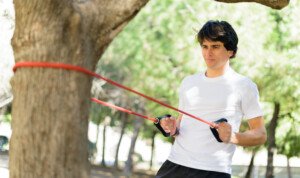
Row. Shutterstock/Aaron Amat
Loss of muscle, beginning at around age 30, starts occurring in people who don’t do strength training – structured weight-bearing workouts. This muscle loss equates to about five pounds per decade.
So even though an elderly woman may still be able to “fit” into her wedding dress of decades past, her body composition has radically changed if she’s been losing five pounds of muscle every decade!
“Our analyses of current research show that the most important factor in somebody’s function is their strength capacity,” states Mark Peterson, PhD, in a University of Michigan Health System study report.
Older people should strength train at least twice a week.
The best exercises that I just named are all compound strength training moves. At the gym, the bench press can replace pushups, or you can do both.
Squat and Pushup Alternatives
An elderly person who’s strong doing body-weight-only squats, can progress to weighted squats on a Smith machine, or with holding dumbbells or weight plates.
A squat with a barbell across one’s back is certainly not out of reach for the fitter 65+ person whose doctor has cleared them for this.
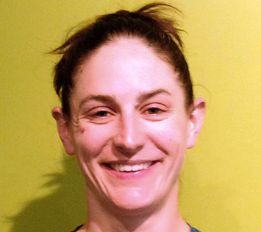 Monica Charlton’s personal training services include fitness/body composition assessments, nutrition planning, running programs and customized programs for clients with disabilities or injuries, as well as older and mainstream clients.
Monica Charlton’s personal training services include fitness/body composition assessments, nutrition planning, running programs and customized programs for clients with disabilities or injuries, as well as older and mainstream clients.
 Lorra Garrick is a former personal trainer certified through the American Council on Exercise. At Bally Total Fitness she trained women and men of all ages for fat loss, muscle building, fitness and improved health.
Lorra Garrick is a former personal trainer certified through the American Council on Exercise. At Bally Total Fitness she trained women and men of all ages for fat loss, muscle building, fitness and improved health.
.

